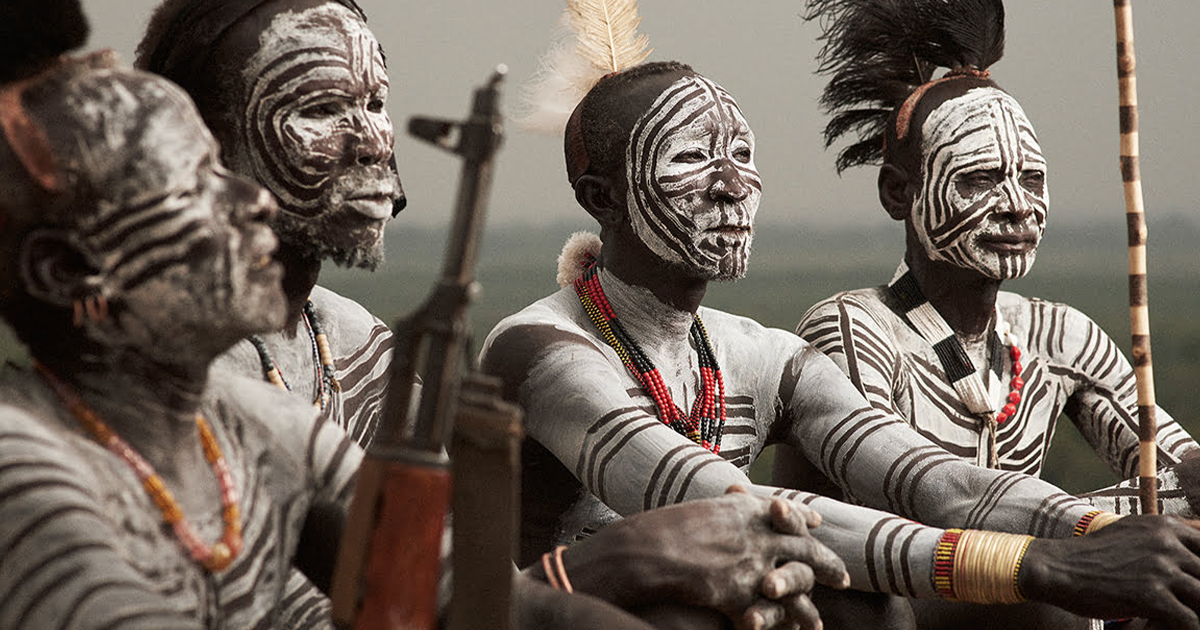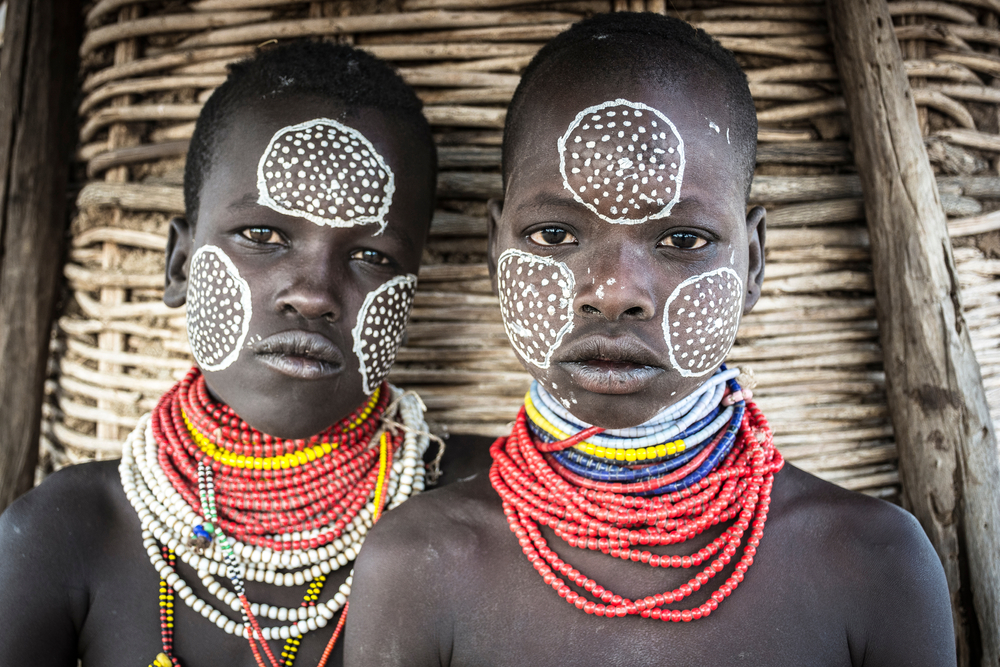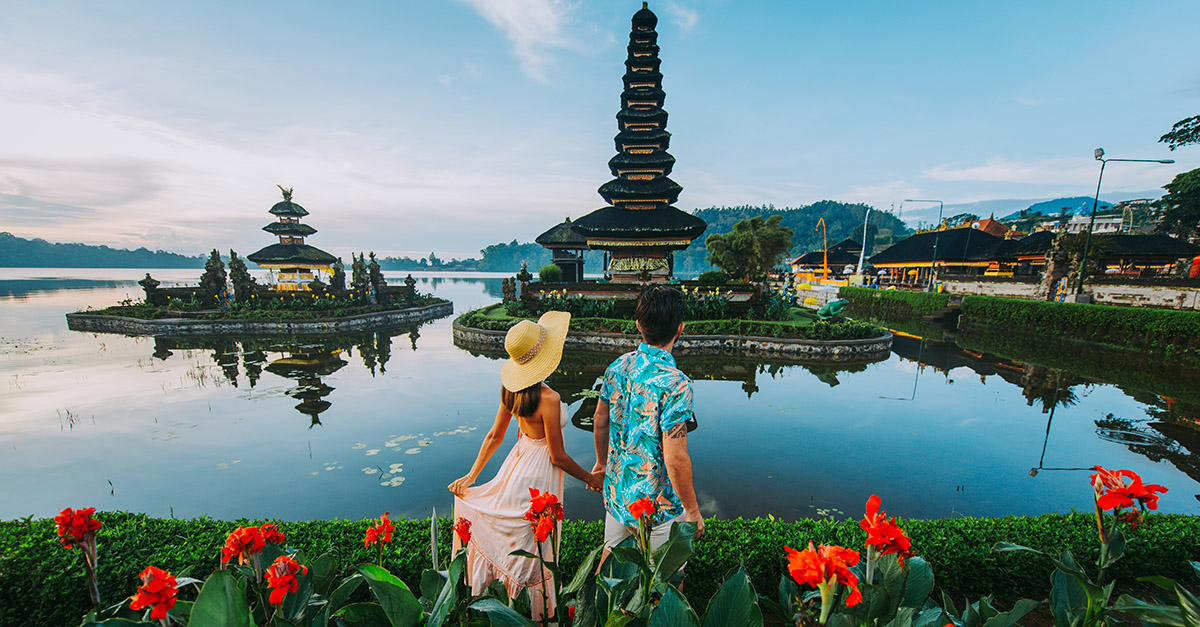The Karo Tribe
The Karo tribe of Ethiopia is renowned for their striking body art, earning them the nickname "The White Chalk Tribe".
But beneath their stunning appearance lies a darker side. From intricate body scarring to deeply unsettling rituals, the Karo tribe carries with it traditions that are both fascinating and chilling.

Location
The Karo tribe lives along the east banks of the Omo River in southern Ethiopia.
Population
The Karo have an estimated population between just 1,000 and 3,000—they are one of the smallest tribes in Ethiopia.
Famous Ability
The Karo tribe is famous for their intricate body and face painting rituals, showcasing a deep attention to appearance.
Their designs range from simple lines and dots to elaborate animal motifs and handprints, each carrying unique cultural significance.
 Matej Hudovernik, Shutterstock
Matej Hudovernik, Shutterstock
Body Painting: What They Use
The Karo people use colored ochre, white chalk, yellow mineral rock and other natural resources to paint themselves.
Body Painting: Significance
Men use clay to create elaborate hairstyles and headdresses that signify status, beauty and bravery. Male and female scarification is also a common practice both for its symbolism and aesthetic beauty.
Body Painting: Rituals
The Karo men cover their body and face with ashes mixed with fat, a symbol of virility for important festivities and the ritual combats between the clans, which take place after the harvest.
Body Painting: Attraction
The ritual combats are a vital part of Karo culture, allowing men to showcase their beauty, strength, and bravery. These battles also serve as an opportunity to attract a potential mate.
But it’s not just the body paint that catches attention—there’s another element the men use to enhance their appeal.
Attraction Techniques
Large beads worn around the neck of a man signify a big game harvest, and the scars and lacerations upon their chest are highly esteemed marks of valor—which Karo women are attracted to.
These scars are not always from hunting or fighting, though.
Body Scarification: Men
The scarification of the man’s chest indicates that he has taken the lives of enemies from other tribes, and he is highly respected within his community.
Body Scarification: Representation
Each line etched onto a Karo man's chest symbolizes a life he has taken, with full chest scarification being a common practice among the tribe.
Women, too, participate in the tradition of body scarification, marking their own bodies with intricate patterns that hold deep cultural meaning.
Body Scarification: Women
The Karo women are considered particularly sensual and attractive if cuts are made deep into their chests and torsos and ash is rubbed in.
This creates a raised effect over time, enhancing their intimate beauty, and making them desirable to men.
Traditions
The Karo people are clearly very skilled artists, and use art for various rituals and ceremonies within their traditional culture.
However, body painting and scarring are not the only things they’re known for.
Home Life
Traditionally, the Karo people were famous for their magnificent houses. After they lost their wealth, they adopted much more discreet conical huts.
Their villages are smaller than before.
Village Size
A typical Karo village today consists of 20 to 30 huts arranged around a central meeting area, with enclosures made of branches to house cattle and goats. This communal setup reflects their close-knit lifestyle and connection to the land.
Houses
Each Karo family owns two houses: the Ono, the main living room of the family, and the flat-roofed Gappa, the center of household activities.
Sleeping Arrangements
When it comes to sleeping, the men and women both sleep on the ground. They may use available cloths for added comfort, and the men use their headdress as pillows.
Aside from those two huts, there’s another family hut of importance.
The Men’s Hut
In addition to the two main huts that make up their homes, the Karo tribe has special men's huts called "chifo", where they go to rest and relax.
There’s also another significant hut for men, one that plays a crucial role in their cultural and social life.
The Ceremonial Hut
The tribe has a ceremony hut, called “Marmar” where married men speak of important matters to the tribe.
Their marriage rituals are very specific too.
Social Structure
The Karo have created a complex social hierarchy where they avoid intermarriage (marrying within their own tribe) in order to try and keep their lineages pure.
The Karo tribe often marries with the Kwegu tribe.
Marriage: Girls
Girls get married whenever the scarification process is complete. The scarification process for them usually begins around age 12, during a coming-of-age ceremony.
Girls’ Coming-of-Age Ceremony
During this ritual, a girl's skin is pulled tight and cut with a razor blade, a process that lasts about ten minutes and involves multiple cuts.
Her ability to endure the pain is seen as a reflection of her emotional maturity and her readiness for the responsibilities of motherhood.
Marriage: Boys
Men marry once they complete the bull jumping ceremony—and initiation rite which signifies the coming-of-age.
Boys’ Coming-of-Age Ceremony
A coming-of-age ceremony involves leaping over rows of cattle six times consecutively without falling.
If successful, the boy will become eligible for marriage (as long as his older brothers are already married) and he will be allowed to appear publicly with the elders in sacred areas.
Marriage: Plural
Men in the Karo tribe can have as many wives as they can afford, though most typically marry two or three women.
Before marrying each wife, a payment is made, marking the start of the marital union.
Marriage: Dowry
Karo marriages require “bride wealth”—a payment made to the woman’s family generally consisting of goats, artilleries and numerous cattle.
Also, women are allowed to choose their own husbands during a ceremonial dance.
Marriage: Adultery
Adultery is considered an insult and shame to one’s family. Divorce is possible, but it must be negotiated.
Women have very little freedom when it comes to their intimate nature.
Women’s Intimate Freedoms
Women can only be intimate if they are married, and only to their husband. This is strictly because they have no means of contraception, and when a child is born out of wedlock, it is a serious (and sad) situation.
Children Born Out of Wedlock
In the Karo tribe, a child born out of wedlock is considered an "abomination," and tragically, their life is taken. The woman involved is also subjected to public shame. This act is deemed "unpardonable" in their culture.
Sadly, this is not the only heartbreaking ritual involving Karo children.
The Practice of Mingi Sacrifice
Traditional Karo tribes took part in a dark practice called “mingi”—meaning child sacrifice.
There are a number of incidences when a child would be considered “mingi”, and a consequence would follow.
Mingi Children
A “mingi baby” was said to be any child born a twin, babies born to unwed mothers or to married parents who fail to perform certain rituals for the elders, and children whose upper milk teeth erupt before the lower ones.
But what they did to mingi babies is where it gets dark.
The Mingi Baby Curse
The Karo tribe believed that disasters like droughts and epidemics could be prevented by sacrificing "cursed" children.
Children born with certain perceived flaws, known as "mingi," were considered cursed and were sadly taken to prevent misfortune from befalling the community.
 Vladislav Belchenko, Shutterstock
Vladislav Belchenko, Shutterstock
Mingi Baby Sacrifice
Babies considered “mingi” would have their mouths stuffed with dirt, and abandoned in the bush and scavenged by predators or thrown into the crocodile-infested river.
Their little bodies were never buried for fear the earth itself would become infertile.
If that isn’t bad enough, it gets worse.
 Marco Polo's Rhino, Shutterstock
Marco Polo's Rhino, Shutterstock
Mingi Ages
Taking the lives of infants is never justified. When a newborn is an obvious mingi baby—a twin, born out of wedlock, or physically disabled—they are taken away immediately.
But a “tooth mingi” is a baby whose upper teeth erupt before the lower ones—meaning they are usually almost a year old when this occurs, sometimes older.
Tooth Mingi Babies
The “tooth mingi” toddlers are immediately taken away from their mothers as soon as the elders determine the child as a mingi.
This is often a very difficult time in the village as the baby has come to be well loved among many by that age.
The Mingi Practice
Thankfully, the practice of Mingi was abolished in 2012. Today, shelters are available for Mingi children, ensuring they no longer face the threat of losing their lives. However, they still do not live within the village, as the community remains cautious about integrating them fully.
Kinship
Healthy Karo children act like normal kids. Boys and girls play together while they are still young and have minimal responsibilities. Babies are well loved by the entire community.
Once they reach mid-childhood though, things change.
Gender Roles
Once children reach a certain age of maturity, somewhere around 8-10 years old, the girls become responsible for helping the women with chores, and the boys are tasked with taking care of the cattle.
 Vladislav Belchenko, Shutterstock
Vladislav Belchenko, Shutterstock
Community Roles: Midwife
Each Karo village has at least one midwife, who is also skilled in basic traditional medicine. With no access to Western healthcare, the tribe relies on plant-based remedies and healing rituals passed down through generations.
Community Roles: Elders
Each Karo village has a group of elders. The elders make important decisions and are the main players in most ceremonies.
Once a man becomes an elder, he adds something to his “look”.
Haircuts
Men always shave their head while women plait their hair into many braids and decorate them with beads.
But then there’s a specific hair piece that is worn by both genders.
The Clay Hairbun
The clay hairbun, sported by both men and women can take up to three days to construct and is usually re-made every three to six months, but can be worn for up to a year.
Typically, men wear a grey and red clay hairbun once they are considered brave and courageous. When they become elders, they add ostrich feathers to their hairbun.
Clothing: Women
Karo women typically wear only a loincloth made from hide, adorned with colorful beads around their necks. They lather their hair with a mixture of ochre and animal fat, and, of course, decorate their bodies with intricate paint.
Clothing: Men
Men wear only a piece of cloth wound around the waist that extends to the knee cap. An extra cloth is slung over their shoulder.
They use hides and skins from animals to make some of their clothing.
Cultivation
The Karo traditionally practiced “flood retreat agriculture,” using silt left by floodwaters that occur during the monsoon season to fertilize their crops. They also fish and breed cattle and goats.
Basically, they rely on the natural flooding for their survival. But this isn’t their only way of ensuring survival.
Protection
Traditionally, the Karo tribe crafted their own tools for protection. Today, however, they are commonly armed with AK-47s, which are primarily used to protect cattle, hunt, and settle disputes. Few men are ever seen outside the community without them.
But how did the Karo come to possess such powerful weapons?
Introduction of the Modern World
Only recently, the modern world has begun to creep into their existence, especially with plastic water containers and automatics.
The end of the Mengistu reign in the 1990s and ongoing conflict in Sudan and Somalia have ensured a flood of AK-47′s, Kalashnikovs and G-3 rifles into the region.
That’s not all the modern world brought.
Income
Today, the Karo tribe earns an income that helps support their protective lifestyle. Many of them use their artistic abilities to paint their bodies and charge outsiders a fee for taking photographs of them.
Some of them have been paid quite well for official roadside photoshoots.
 Aleksandra Kossowska, Shutterstock
Aleksandra Kossowska, Shutterstock
Visiting the Karo Tribe
While it's possible to photograph the Karo tribe from the side of the road, visiting them up close is a more complex matter. Travelers can head towards the tribe, but they’ll be kept at a distance.
Only those who offer payment—whether in money or supplies—are allowed to get closer and interact with the tribe.
Final Thoughts
Known for their stunning body art, the Karo tribe has some dark rituals that set them apart from many other modern-day tribes.
Although has access to limited modern-day amenities, they prefer to stay put in their villages and practice their traditional lifestyle.



















































